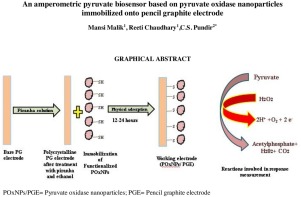当前位置:
X-MOL 学术
›
Process Biochem.
›
论文详情
Our official English website, www.x-mol.net, welcomes your feedback! (Note: you will need to create a separate account there.)
An amperometric pyruvate biosensor based on pyruvate oxidase nanoparticles immobilized onto pencil graphite electrode
Process Biochemistry ( IF 4.4 ) Pub Date : 2020-06-01 , DOI: 10.1016/j.procbio.2020.03.008 Mansi Malik , Reeti Chaudhary , C.S. Pundir
Process Biochemistry ( IF 4.4 ) Pub Date : 2020-06-01 , DOI: 10.1016/j.procbio.2020.03.008 Mansi Malik , Reeti Chaudhary , C.S. Pundir

|
Abstract This present study was aimed to fabricate a sensitive and improved amperometric biosensor by the nanoparticles of pyruvate oxidase, which were prepared and immobilized covalently onto pencil graphite electrode. The biosensor showed ideal working within 5 s under defined conditions of pH 6.0 and incubation temperature of 30 °C at an applied voltage of -0.1 V. Under standard assay conditions, a linear response was obtained between pyruvate concentration ranging from 0.001 to 6000 μM and current (μA). A lower detection limit (0.58 μM) and an excellent correlation coefficient (R2 = 0.999) with standard spectrophotometric assay was obtained for the present biosensor. Within and between batches of coefficients of variation were calculated and found to be 3.61 % and 3.33 %, respectively. The biosensor was put to continual use for over 210 days. The biosensor was employed for the measurement of pyruvate level in sera of normal healthy individuals and persons suffering from heart disease.
中文翻译:

基于固定在铅笔石墨电极上的丙酮酸氧化酶纳米颗粒的安培法丙酮酸生物传感器
摘要 本研究旨在通过制备并共价固定在铅笔石墨电极上的丙酮酸氧化酶纳米颗粒来制造一种灵敏且改进的电流型生物传感器。该生物传感器在 pH 6.0 的规定条件和 30 °C 的孵育温度和 -0.1 V 的施加电压下显示出理想的工作状态。 在标准测定条件下,丙酮酸浓度范围为 0.001 至 6000 μM 和电流 (μA)。本生物传感器通过标准分光光度测定法获得了较低的检测限 (0.58 μM) 和极好的相关系数 (R2 = 0.999)。计算批次内和批次之间的变异系数,发现分别为 3.61% 和 3.33%。生物传感器连续使用了 210 多天。
更新日期:2020-06-01
中文翻译:

基于固定在铅笔石墨电极上的丙酮酸氧化酶纳米颗粒的安培法丙酮酸生物传感器
摘要 本研究旨在通过制备并共价固定在铅笔石墨电极上的丙酮酸氧化酶纳米颗粒来制造一种灵敏且改进的电流型生物传感器。该生物传感器在 pH 6.0 的规定条件和 30 °C 的孵育温度和 -0.1 V 的施加电压下显示出理想的工作状态。 在标准测定条件下,丙酮酸浓度范围为 0.001 至 6000 μM 和电流 (μA)。本生物传感器通过标准分光光度测定法获得了较低的检测限 (0.58 μM) 和极好的相关系数 (R2 = 0.999)。计算批次内和批次之间的变异系数,发现分别为 3.61% 和 3.33%。生物传感器连续使用了 210 多天。



























 京公网安备 11010802027423号
京公网安备 11010802027423号